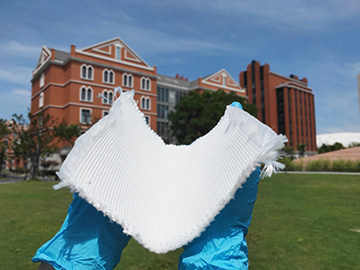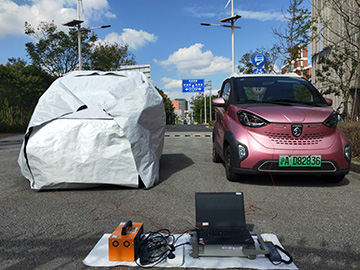Scientists have tested a new type of thermal cloak on electric vehicles in Shanghai, showing that it outperforms both uncovered cars and those subject only to radiative cooling. They say that their “Janus,” or two-faced, thermal cloak is robust and easy to scale up. [Image: Huaxu Qiao] [Enlarge image]
Scientists in China have designed and tested a new type of heat cloak that can be used to keep large objects cool in summer-like conditions and warm in the winter. Their “Janus thermal cloak” is made of two components, which together enable both radiative cooling and heat retention—allowing the inside of an electric vehicle to be maintained well below the ambient temperature when hot and, crucially, considerably above the ambient temperature when cold. They also say that the technology is robust, potentially cheap and easy to scale up (Device, doi: 10.1016/j.device.2023.100008).
Exploiting the biggest heat sink of all
Devices that can regulate the temperature of buildings, cars and other objects without themselves consuming energy are currently the object of much research. According to the International Energy Agency, heating and cooling make up half of buildings’ energy consumption and a fifth of all the energy used in the world.
One particularly promising energy-saving approach is so-called radiative cooling. This exploits the fact that much of the blackbody spectrum of an object at normal room temperature—about 300 K—coincides with the 8-to-13-µm wavelength range, across which the atmosphere is very transparent. Best suited to well-insulated objects placed under clear skies at night, the technique relies on radiating thermal energy away to the cool emptiness of outer space, an enormous heat sink with a temperature of just 3 K (see “Radiative cooling: Harvesting the coldness of the universe,” OPN, November 2019).
Seasonal dilemmas
Radiative cooling relies on radiating thermal energy away to the cool emptiness of outer space, an enormous heat sink with a temperature of just 3 K.
In recent years, scientists have shown how radiative cooling can even be exploited under the daytime sun, by using nanophotonic structures to control an object’s emissivity so that it reflects almost all of the solar spectrum while still emitting at thermal-infrared wavelengths. This poses a problem, however, when thermal protection is required throughout the year; an object will continue to radiate its heat to space during the winter months, making it cooler than desired.
Researchers are looking at a number of ways around this. But all have their downsides. Thermochromic coatings can reduce thermal emission when the temperature drops below a certain level, thanks to the material switching from a metal to an insulator, but emittance isn’t entirely stopped, so some extra heating is needed. Alternatively, electrical signals can switch the state of an electrochromic material, but this option requires extra energy and also maintenance.
Two-faced thermal cloak
In the latest work, Kehang Cui and Huaxu Qiao at Shanghai Jiao Tong University, together with colleagues in Shanghai and Wuhan, have instead developed a thermal cloak comprising two distinct materials with contrasting functions—hence the cloak’s name: that of the two-faced Roman god Janus.
The outermost component, which acts as the radiative cooler, is a “phononic metafabric” made of narrow silica fibers that are coated with flakes of boron nitride and then woven together. The silica is an effective reflector of solar radiation, but cannot emit thermal wavelengths across the whole atmospheric window. The boron nitride, structured on a hexagonal lattice, ensures complete coverage in this range, and therefore the greatest possible radiative cooling.

The radiative-cooling layer of the team’s two-sided cloak is a “phononic metafabric” consisting of silica fibers coated with flakes of hexagonal boron nitride. [Image: Huaxu Qiao]
To complete the cloak, the metafabric is stacked on top of an aluminium alloy foil. This foil traps heat by reflecting light back from the object across the entire range of optical wavelengths—an effect known as photon recycling—and thereby keeps the object warmer than it otherwise would be at night or in the winter.
Cloaking an e-car
Cui and colleagues tested a large prototype of their cloak by using it to cover a commercial electric car and comparing the subsequent temperature in the vehicle with that of an identical uncovered one. At noon on a sunny day at the end of October, at an ambient temperature of about 27°C, they measured a mere 23°C in the cloaked vehicle—versus a whopping 51°C inside the uncovered one.
The team also found that the cloak significantly reduced the temperature of the car’s battery, which is itself covered with materials that block light and conduct heat away. The battery in the covered car remained up to 8 °C cooler than that in the uncovered one, according to the authors—which, they say, should help prolong battery life and lower the risk of explosive thermal runaway.
More important, the researchers showed that the cloak has the opposite effect in winter. During the night in December, the temperature inside the covered car was about 5 °C warmer than it was in the uncovered vehicle, while the battery in the former remained about 3 °C warmer than its counterpart did.
Their tests didn’t stop there, however. At a later date, the researchers also compared the performance of their Janus cloak with that of the radiative-cooling metafabric layer only. The result, they write, was “counter-intuitive”; they found that on a warm day the full cloak kept its car up to 10 °C cooler than did the metafabric only, even though the additional layer was designed to keep heat in during the winter.
“Useful effect”
Jiachen Li of the University of California, Berkeley, USA, who was not involved in the research, explains that this effect is likely due to the dual role of the metal foil. While this layer reflects the object’s own heat back toward itself, it also blocks emission from the radiative cooler—which, after all, emits both out toward space and back toward the object. During the daytime the cooling effect of blocking the downward radiative emission presumably exceeds the warming effect of the photon recycling; hence the foil’s overall cooling effect.
Li says that the Shanghai-led group has “discovered a very useful effect” in this additional cooling. He adds that the effect would have been less relevant to earlier work involving radiative cooling of roofs, where thermal conduction plays a more important role. Instead, he explains, it becomes useful where the cloaking material is only loosely attached to the object.
Ready to scale up?
The team argues that the Janus cloak is well suited to outdoor and even space-based applications.
Cui and colleagues argue that the Janus cloak is well suited to outdoor and even space-based applications. They point out that it’s lightweight and made from reasonably cheap, abundant materials. And, they maintain, they have designed the cloak so that it can be scaled up, having opted for the strength and industrial compatibility of 5-to-8-µm-diameter fibers rather than the superior scattering of narrower fibers. They also report that the cloak can withstand harsh environments, including significant heating, cooling, corrosion and vibration.
Li, however, notes that the photon-recycling effect exploited in the Janus cloak is compatible with other existing materials, including some that adapt to temperature changes. Given that such adaptive materials would benefit from both thermal reflection and the switching-off of thermal emission, he expects that they would work even better than the new cloak does at night.

